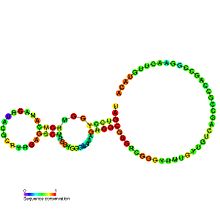| glutamate receptor, ionotropic, kainate 4 | |||||||
|---|---|---|---|---|---|---|---|
| Identifiers | |||||||
| Symbol | GRIK4 | ||||||
| Alt. symbols | GRIK, KA1 | ||||||
| NCBI gene | 2900 | ||||||
| HGNC | 4582 | ||||||
| OMIM | 600282 | ||||||
| RefSeq | NM_014619 | ||||||
| UniProt | Q16099 | ||||||
| Other data | |||||||
| Locus | Chr. 11 q | ||||||
| |||||||
| GRIK4 3 prime UTR element | |
|---|---|
 Secondary structure identified in the 3' UTR of the GRIK4 transcript Secondary structure identified in the 3' UTR of the GRIK4 transcript | |
| Identifiers | |
| Symbol | GRIK4_3p_UTR |
| Rfam | RF01383 |
| Other data | |
| RNA type | Gene; |
| Domain(s) | Eukaryota; |
| SO | SO:0001263 |
| PDB structures | PDBe |
GRIK4 (glutamate receptor, ionotropic, kainate 4) is a kainate receptor subtype belonging to the family of ligand-gated ion channels which is encoded by the GRIK4 gene.
Function
This gene encodes a protein that belongs to the glutamate-gated ionic channel family. Glutamate functions as the major excitatory neurotransmitter in the central nervous system through activation of ligand-gated ion channels and G protein-coupled membrane receptors. The protein encoded by this gene forms functional heteromeric kainate-preferring ionic channels with the subunits encoded by related gene family members.
Clinical significance
A single nucleotide polymorphism (rs1954787) in the GRIK4 gene has shown a treatment-response-association with antidepressant treatment.
Variation in GRIK4 have been associated with both increased and decreased risk of bipolar disorder. A possible mechanism for this observation is that the sequence variation influences secondary structures in the 3' UTR.
Interfering with GRIK4/KA1 function with a specific anti-KA1 antibody protects against kainate-induced neuronal cell death.
A test of that gene can be made in order to know if a depressed patient will respond to the SSRI citalopram.
Evolutionary significance
The GRIK4 gene displayed significantly higher rates of evolution in primates than in rodents and especially in the lineage leading from primates to humans. Furthermore, the GRIK4 gene is implicated in the development of the nervous system. Hence evolution of the GRIK4 gene is thought to have played a role in the dramatic increases in size and complexity of the brain that occurred during evolutionary history leading to humans.
References
- Szpirer C, Molné M, Antonacci R, Jenkins NA, Finelli P, Szpirer J, Riviere M, Rocchi M, Gilbert DJ, Copeland NG (December 1994). "The genes encoding the glutamate receptor subunits KA1 and KA2 (GRIK4 and GRIK5) are located on separate chromosomes in human, mouse, and rat". Proceedings of the National Academy of Sciences of the United States of America. 91 (25): 11849–53. Bibcode:1994PNAS...9111849S. doi:10.1073/pnas.91.25.11849. PMC 45333. PMID 7527545.
- "Entrez Gene: GRIK3 glutamate receptor, ionotropic, kainate 4".
- ^ Paddock, Silvia; Laje, Gonzalo; Charney, Dennis; Rush, A. John; Wilson, Alexander F.; Sorant, Alexa J.M.; Lipsky, Robert; Wisniewski, Stephen R.; Manji, Husseini; McMahon, Francis J. (2007). "Association of GRIK4 With Outcome of Antidepressant Treatment in the STAR*D Cohort". American Journal of Psychiatry. 164 (8): 1181–1188. doi:10.1176/appi.ajp.2007.06111790. ISSN 0002-953X. PMID 17671280. S2CID 13306769.
- Pickard BS, Knight HM, Hamilton RS, Soares DC, Walker R, Boyd JK, Machell J, Maclean A, McGhee KA, Condie A, Porteous DJ, St Clair D, Davis I, Blackwood DH, Muir WJ (September 2008). "A common variant in the 3′UTR of the GRIK4 glutamate receptor gene affects transcript abundance and protects against bipolar disorder". Proceedings of the National Academy of Sciences of the United States of America. 105 (39): 14940–5. Bibcode:2008PNAS..10514940P. doi:10.1073/pnas.0800643105. PMC 2567472. PMID 18824690.
- "Discovery Could Help Scientists Stop 'Death Cascade' Of Neurons After A Stroke". Science News. Science Daily. 2009-01-20. Retrieved 2009-01-20.
- Chen ZL, Yu H, Yu WM, Pawlak R, Strickland S (December 2008). "Proteolytic fragments of laminin promote excitotoxic neurodegeneration by up-regulation of the KA1 subunit of the kainate receptor". J. Cell Biol. 183 (7): 1299–313. doi:10.1083/jcb.200803107. PMC 2606967. PMID 19114596.
- "GRIK4, HTR2A markers indicate reduced risk of nonresponse to citalopram". Science News. Science Daily. Retrieved 2009-01-20.
- Dorus S, Vallender EJ, Evans PD, Anderson JR, Gilbert SL, Mahowald M, Wyckoff GJ, Malcom CM, Lahn BT (December 2004). "Accelerated evolution of nervous system genes in the origin of Homo sapiens". Cell. 119 (7): 1027–40. doi:10.1016/j.cell.2004.11.040. PMID 15620360. S2CID 11775730.
External links
- GRIK4+protein,+human at the U.S. National Library of Medicine Medical Subject Headings (MeSH)
- Page for GRIK4 3 prime UTR element at Rfam
This article incorporates text from the United States National Library of Medicine, which is in the public domain.
| Ion channel, cell surface receptor: ligand-gated ion channels | |||||||||||
|---|---|---|---|---|---|---|---|---|---|---|---|
| Cys-loop receptors |
| ||||||||||
| Ionotropic glutamates |
| ||||||||||
| ATP-gated channels |
| ||||||||||